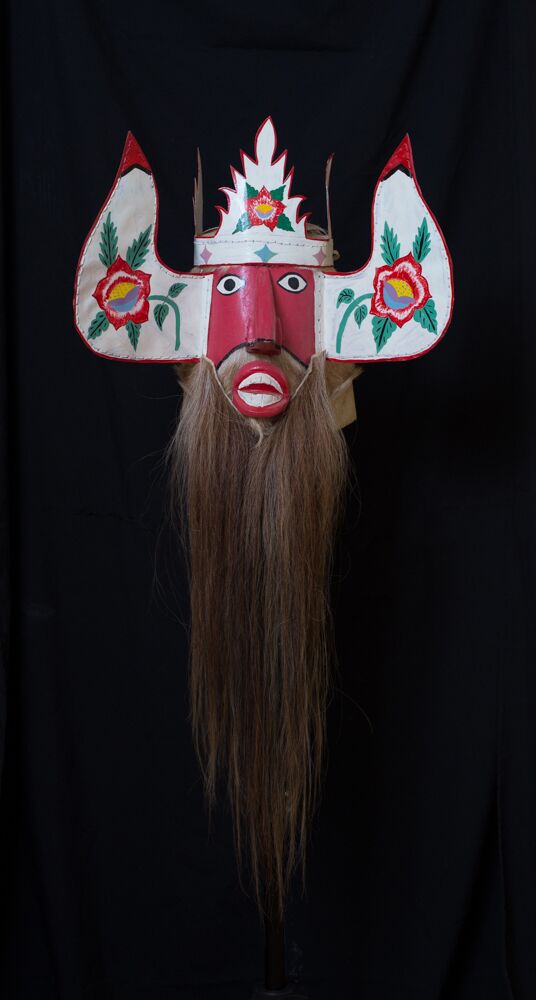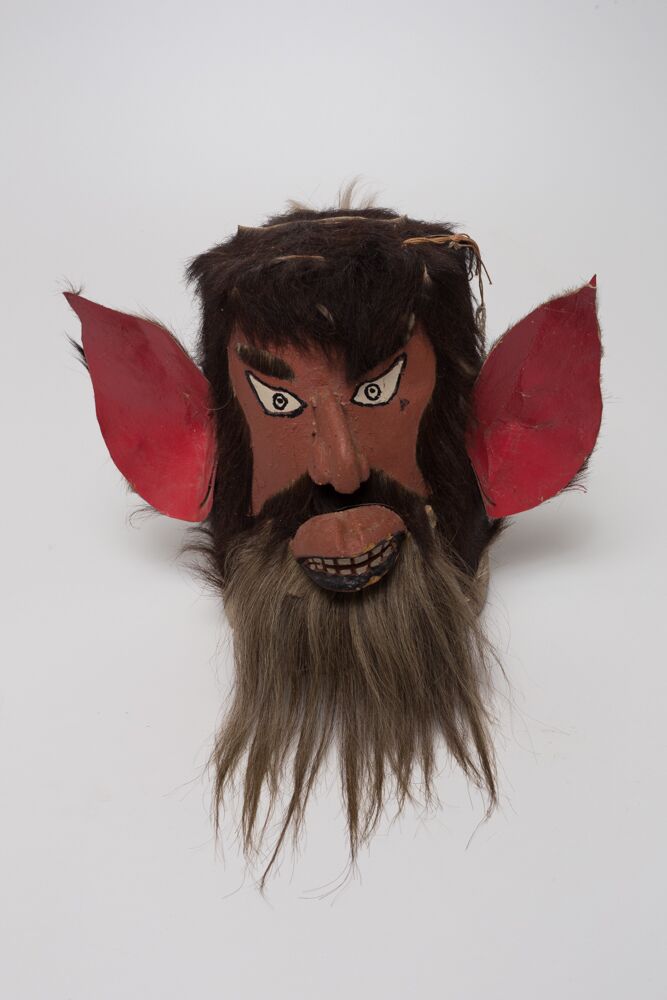-
 Máscara de chapayeca_2303Download
Máscara de chapayeca_2303Download
Chapayeca mask handcrafted in tanned leather, painted with enamel, and hair and horsehair applications. His appearance is anthropomorphic with grotesque purposes, he has an open mouth; instead of ears it has horns decorated with flower drawings, this type of ears being the most representative; in the upper part a crown, and a long and pointed nose (chapala yekak), hence the name of the mask. It is used by members of the Order of the Chapayecas or Pharisees throughout Lent. The reason for its appearance is to represent those who, according to the Catholic religion, killed Jesus: Jews and Roman soldiers. There is a great diversity of chapayeca masks, since each of them, in addition to representing the Pharisees, also symbolizes the sins of the members of the community. Through the mask, other aspects of the person who represents it can be known, for example, if it brings a large feather, the person, in addition to being a chapayeka, is a matachín or matachín musician; if he brings naka monkfish (colored flecks) it means that he is also an "ophysio" (being a pascola dancer, deer dancer, "tampaleo" or pascola drummer, deer singer or violinist). This particular mask was made by an artisan for display purposes in the museum and not for oficial ceremonial use, the reason for this is that almost all the original masks are burned on Glorious Saturday or Sabado de Gloria in the Judas bonfire, for the purification ritual.
Metadata
Title
Chapayeca Mask
Alternative title
Chapayeka chóomo
Creator
Yaqui tribe
Created
2008
Type
Description
Physical object:
Dimensions: 46 X 36 X 28 cm.
Technique: Horsehair marquetry, mirror and enamel on wood
Description
Chapayeca mask handcrafted in tanned leather, painted with enamel, and hair and horsehair applications. His appearance is anthropomorphic with grotesque purposes, he has an open mouth; instead of ears it has horns decorated with flower drawings, this type of ears being the most representative; in the upper part a crown, and a long and pointed nose (chapala yekak), hence the name of the mask.
It is used by members of the Order of the Chapayecas or Pharisees throughout Lent. The reason for its appearance is to represent those who, according to the Catholic religion, killed Jesus: Jews and Roman soldiers. There is a great diversity of chapayeca masks, since each of them, in addition to representing the Pharisees, also symbolizes the sins of the members of the community. Through the mask, other aspects of the person who represents it can be known, for example, if it brings a large feather, the person, in addition to being a chapayeka, is a matachín or matachín musician; if he brings naka monkfish (colored flecks) it means that he is also an "ophysio" (being a pascola dancer, deer dancer, "tampaleo" or pascola drummer, deer singer or violinist).
This particular mask was made by an artisan for display purposes in the museum and not for oficial ceremonial use, the reason for this is that almost all the original masks are burned on Glorious Saturday or Sabado de Gloria in the Judas bonfire, for the purification ritual.
Subject
Religion and culture--Sonora (Mexico : State)--Holy Week | Religious dance--Mexico | Sculpture--Mexico--Ethnic groups
Format
Still image / jpg
Spatial
Sonora , Cócorit
Temporal
2001 - 2010
Is part of
Hall of traditional festivities, Museum of the Yaqui people
Provenance
Museum of the Yaqui people. Sinaloa and Obregon No. 200, Cocorit, Cajeme, Sonora
Acquired for the reopening of the museum in the town of Cócorit. It is exhibited in the traditional festival room of the Museum.
Language
eng , yaqui
Date
2021-09-14
Identifier
Web Catalogación Obregón 2016 - 2303
ISC-CGPC-MY-0002
RS-OM-MEY-02
Relationship
Chapayeca knife | Chapayeca Sword | Chapayeca Mask | Banners of red cultural participants and chapapayecas | Chapayeca | Chapayeca flute | Drum
Contributor
Sonoran Institute of Culture
Casanova, Juan (photography)
Buitimea Flores, Teodoro; Ruiz Félix, José María (investigation)
Valencia, Carlos ; The Yaqui Pride Project (translation to english)
License

This work is licensed under a Creative Commons Attribution-NonCommercial-ShareAlike 4.0 International License.
Rights
Sonoran Institute of Culture


